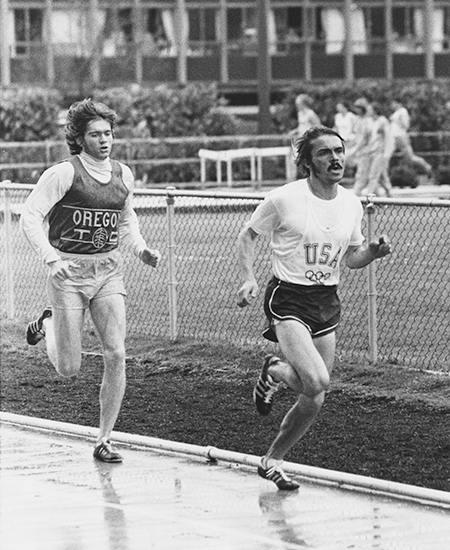
HERE, IN THE 11th chapter of a long multi-part series, is how we reported the career of Steve Prefontaine in our pages from April through his final outdoor NCAA Championships in June. We have taken the liberty of doing some stylistic updatings to mirror our modern protocol and also added an editorial comment or three.
II April 1973: Pre Zips 3:56.8, Gets Double Best With 13:06.4
Eugene, Oregon, April 14—Steve Prefontaine cruised to history’s finest ever 1-day mile/3M double, Benny Brown blasted ’73’s fastest 1-lap sprint, Todd Lathers ran and waded to the fastest steeple by an American this year and Harry Freeman again triple jumped longer than any other collegian has this season.
Results of a big invitational or international meet? No, merely a 4-way college affair among UCLA-Oregon-Nebraska-Washington State, won convincingly by the Californians. Touted as a mighty team confrontation beforehand, the meet proved a showcase for stellar performances aplenty by individual athletes.
No star shone brighter than Steve Prefontaine. He got rolling with a fine mile, 3:56.8 to be exact, just 0.1 off his personal best. He let teammates Mark Feig and Scott Daggatt tow the field past a 59.1 first-lap post before assuming command; Pre then timed 1:59.0 and 2:58.4 before spurting a 58.4 last lap. “I wasn’t even pointing for anything near that fast,” Pre said later. “It was very easy and I just ran the way I felt.”
Some 65min later, Pre went into battle in the 3M. He lagged well behind Washington Staters John Ngeno and Phil Burkwist for better than a mile but suddenly ran hard for a straightaway and took the lead. Ngeno stayed close and regained the front on the 7th circuit, Pre dropping back as much as 30y. But the pace didn’t increase and 3 laps later, Pre forged ahead to stay. He hit the wire in 13:06.4—completing the fastest-ever double for the distances. His efforts totaled 1978 Portuguese points, 29 more than Kip Keino’s 3:53.1/13:31.6 in ’67.
II April 1973: New Pre Record—A Smashing Double
Steve Prefontaine didn’t plan to run a mile and a 3M faster than anyone ever has on one day. He just ran the way he felt—and what he felt was worth 3:56.8 and 13:06.4, world leaders both and combining the fastest 1-day mile/3M double in history.
“I thought I would end up doubling if the meet was close with UCLA,” says the gregarious Oregon senior of the super-super feat of the super 4-way Oregon-UCLA-Washington State-Nebraska meet. “I didn’t think I would have to run that fast, though. I suppose I didn’t—but I wasn’t about to turn around and see where the others were. They really, made me work for it.”
First came the mile: “It was a planned effort. I sat down with Mark Feig and Scott Daggatt and told them I didn’t want to do all the work the first quarter but that after, I would help them out with a fast pace in the second and third laps. I wanted a 60-61sec first lap and I did 59.1. Then I took over and ran 1:59.0, 2:58.4 and a 58.2 last quarter. It was very easy and I was pleased to come within 0.1 of my best. I wasn’t even pointing for that, but just running the way I felt. That’s what I have been doing pretty much all year, not shooting for any particular thing but just running how I feel.
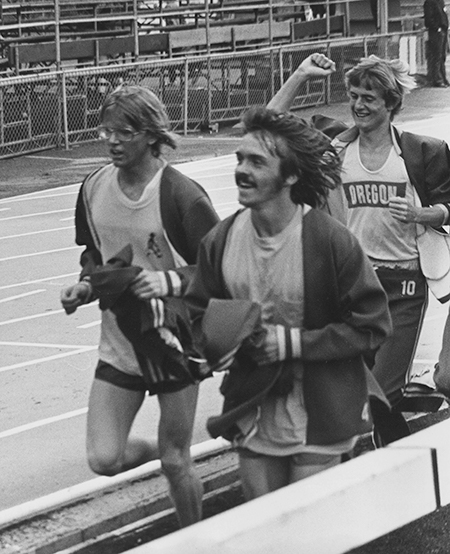
“The 3M was very pleasing because it indicated I could probably have broken the World Record with an all-out effort just in the 3M. I think I could have run even harder if I had known my time. I didn’t realize I was that close to 13:00 until the last 180y; I picked it up then. It was a tough race because [Washington Staters John Ngeno and Phil Burkwist] took us through 2M in 8:46 and I could feel that. At one time, Ngeno had 25y or so on me and I just let him do the work. I could see him tiring with about 4 laps left so I went for the lead. That was my strong point in a race anyway so he could run my race then. I really didn’t feel that great and ran only 62sec for the last lap. I was tired at the end and I’m still tired 6 days later.”
Was there any reason to expect such a performance? “The week of the meet was the first time I had rested in over 4 months,” Pre reveals. “I hadn’t rested since I started back training in November. I’ve been running 85–90M a week, even training through my meets. But that week I dropped down to about 80M and decided to see what I could do-and it felt very good.
“I’m a long way from being in what I consider good shape. I feel I’m ahead of last year and this could be my best year ever. Actually I think if I had run cross country last fall, I would have gotten very tired of it. I needed a rest, mental and physical, after the ’72 season.
“To double like that doesn’t take any special psych or buildup. I just did what I felt I had to do. It was fascinating to me to be able to meet a challenge like that. Even though the mile didn’t seem that tiring, it took a lot out of me. In the early part of the 3M, it was very hard for me to mentally adjust because I didn’t think I would have to run that hard. But for me to successfully adjust in the middle of the race was another indication I might be able to successfully meet a lot of situations in the future.
“Sure, it always helps to run in Eugene on my home track in front of ‘my’ people—but I think I could have done it in other places, too. Some have said I can run only in Eugene, but I ran some pretty respectable indoor times this year in other places and I have run respectably in other parts of the US and the world. So I don’t have to be in Eugene to run well. It’s my favorite place to run, but I can run in other places too. I didn’t shoot for that meet at all. My season is progressing well. My big times are still to come.”
Steve Prefontaine’s undefeated ’73 season from a mile through 6M:
8:27.4i—1)Sunkist Invitational, LA 1/20
8:24.6i AR—1)Portland Invitational 1/27
3:59.2i—1)LA Times 2/9
5:06.2m—1)All-Comers, Eugene 3/17
27:09.4 AR—1)Bakersfield 3/24
8:31.8—1)Oregon Invitational, Eugene 3/31
4:03.2—1)v Washington, Eugene 4/7
3:56.8—1)Quad, Eugene 4/14
13:06.4—1)Quad, Eugene 4/14
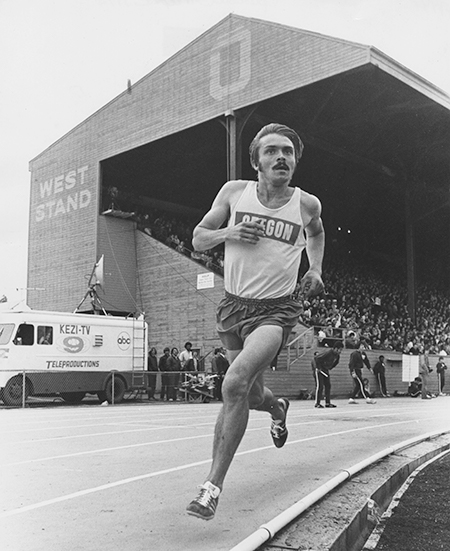
II April 1973: TO BOX 296
I RECENTLY attended a quadrangular meet in Eugene, Oregon, where Steve Prefontaine doubled with a 3:56.8 mile and a 13:06.4 3M. Knowing how you love to surprise your readers with each issue’s cover, I’m afraid this must be truly grim news. Surely, no amount of sophistry will provide you with an excuse not to make Pre your next cover athlete. On the other hand, perhaps you know of a recent 3:49 miler or a 20-foot vaulter of whom I’m unaware.
Gary Darnielle, Springfield, Oregon
I May 1973: Even Pre Surprised With 3:55.0 Mile PR
Eugene, Oregon, April 27—Irrepressible Steve Prefontaine and Oregon coach Bill Dellinger turned out to be rotten predictors as far as the Oregon Twilight Mile (the event of the Oregon Twilight Meet) turned out. “I want them [the milers] to take this in stride,” said Dellinger the day before the meet. “The big meets are ahead of us, and I don’t want this to be their fastest mile of the year.”
“My training hasn’t been going well,” quoth Pre. “I’m very flat—I’m just not up for it.”
“Twice during the meet,” related Dellinger afterwards, “Pre came up and told me he didn’t want to run because his legs were dead. I told him, ‘Look at all those people [6500], they came to see you run.’”
But all the talk was quickly forgotten once the mile got underway. Soph Scott Daggatt was supposed to run through the quarter in 59, but got carried away and blazed a 57. The stage was set. When Todd Lathers let the second quarter lag, Pre and Norwegian Knut Kvalheim forged to the front, passing through the next two posts in 1:58 and 2:58. Then Pre took off.
“I could feel Knut breathing down my back all the way,” he said. “When I moved it felt so good to know I was able to finish strong under those conditions.” And his 57 last trip was enough to give him a big PR 3:55.0, moving to 3rd on the all-time U.S. list, and 9th all-time in the world.
Pretty impressive running under any conditions, and doubly so in light of the 46-degree temperature and 12mph breeze whipping up the homestretch. And, as is customary in this meet, a raft of Ducks followed Pre to the tape in PRs, Kvalheim with 3:58.2, Mark Feig at 4:00.4 and Daggatt at 4:01.0.
I May 1973: US NOTES
Steve Prefontaine is supposed to be a 3-miler, but his exploits in the Twilight Meet (3:55.0) rate him notice as a miler (previous best: 3:56.7) also. “I needed that,” he grinned after the race. “I think if I concentrated on the distance I could be a pretty good miler. Bill [Dellinger] told me I could have run 3:52 under better conditions. I think the record [3:51.1] is in reach.”
As related in our news story of that meet, Pre didn’t really feel up to running before the meet. “The last 10 days, my legs have been dead,” he said. “They didn’t respond after that double against UCLA. I just didn’t have the psyche going; maybe I needed something to blow the tubes out.” As Leo Davis of the Portland Oregonian said: “Nothing clears a man’s head like a 3:55.0 mile.”
II May 1973: Williams’ 27-9w Bumps McAlister
Eugene, Oregon, May 18-19—”Good grief!” exclaimed UCLA long jumper Finn Bendixen. “I jump 26-5¼ and I only get 3rd? If I’d jumped that far at Munich, I would have taken 3rd.” The rest of the Pacific 8 Championships weren’t quite that tough, but they were certainly rough enough to allow the conference to retain its place as the highest-quality collegiate loop in the land…
Visiting schools, notably Washington State (with 2nd in the 880, 2nd in the steeple, 2-3-4 in the 3M and 1-2-3 in the 6M) weren’t too kind to Oregon’s reputation as a distance power, as indefatigable Steve Prefontaine scored the hosts’ only win on the track. Pre, supposedly bothered by a bad back, dueled with 6M winner John Ngeno for 9¾ laps, then burned away for a 13:10.4–13:19.6 win. “It was a fun race and a real challenge,” said the impish Pre. “I pulled every trick out of the hat, including making noises so he would think I was hurting more than I really was.” /Garry Hill/
I June 1973: Pre’s 8:24.6 Tips Geis By 0.2
Eugene, Oregon, May 29—“It was apparent I was doing all the work,” grumbled Steve Prefontaine. Pre had just highlighted the Oregon Twilight II with the season’s quickest 2M, 8:24.6. What griped Pre was Paul Geis, who hung on his shoulder the whole way and recorded a big PR 8:24.8 in 2nd. Only Pre and George Young have ever run faster among Americans. “This ought to answer those who say I have been going downhill,” concluded Pre.
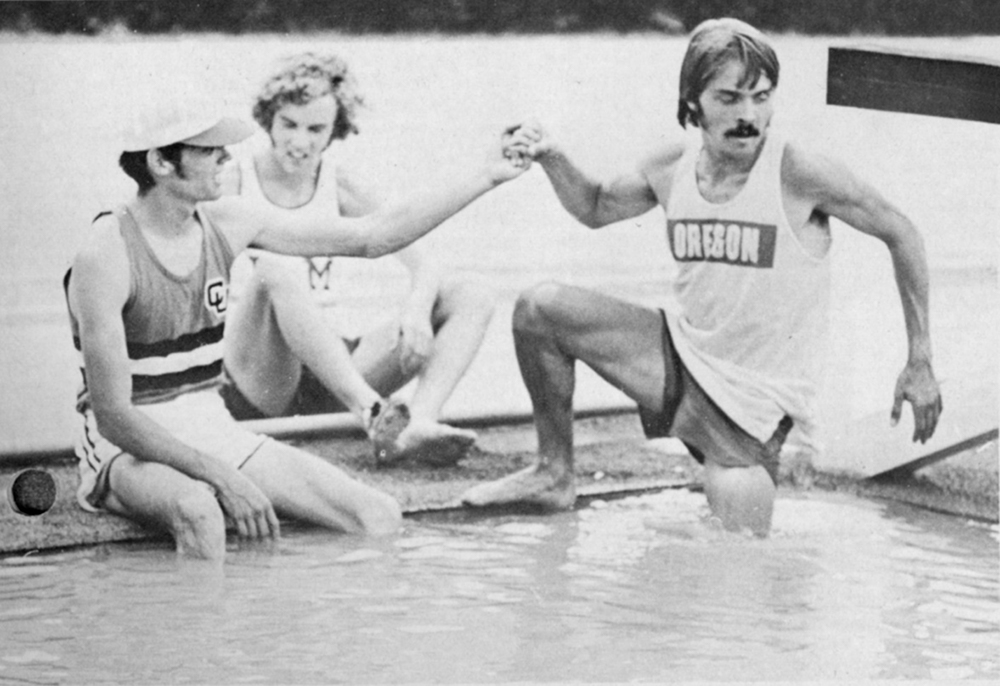
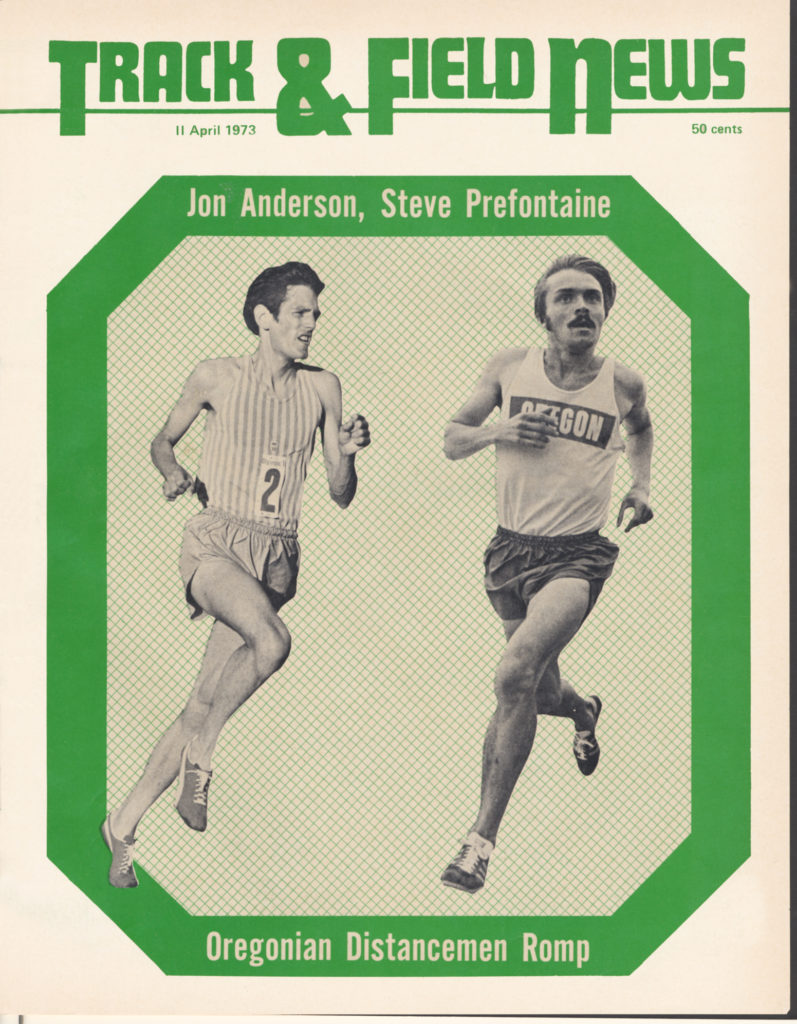
II June 1973: NCAA 3M
Baton Rouge, Louisiana, June 09—Everybody seems to be fascinated with Steve Prefontaine. His irrepressible personality enchants the spectators, sportswriters and, it seems, even his opponents. Why else would John Hartnett or John Ngeno have chosen the 3M when either would have been favored in the 6M had they entered it? “I really want to run against Pre,” said Hartnett. So did Ngeno. So did the rest of them. And they all had about as much chance of winning as they would have had trying to beat Secretariat in the Belmont Stakes, which went off at about the same time.
Pre was simply unstoppable. He lowered his meet record from 13:20.2 to 13:19.0 in a trial heat. He didn’t have to run that fast to qualify, but obviously enjoyed putting on a show by sprinting away to a record followed by a waving victory lap to warm applause.
In the final, he took over the lead near the mile and then started to apply pressure. His first mile was run in 4:28.8 and his second in 4:21.4. When that failed to shake everyone loose, he poured it on even more with quarters of 64.3, 63.0, 64.3 and 62.6 for a 4:15.2 last mile and a 13:05.4 performance, quite respectable considering the heat and humidity. By the middle of the last mile, he was running alone.
Ngeno, who was the last to break pace, found himself overtaken with a little over a lap to go by 2 Coloradans, Big 8 champ Ted Castaneda and surprising John Gregorio. Both were timed in 13:10.6, PRs by substantial margins. The 4th through 8th spots went to foreigners: Ngeno, Mike Keogh, Nick Rose, Ron Martin and Hartnett, all highly respected distance runners. They all paid the price for trying to stay with Prefontaine’s punishing pace.
It was Prefontaine’s final collegiate track race, and he made sure it was an historic one. He became the only athlete ever to win 4 consecutive individual outdoor titles. He was also one of only 2 runners to defend his ’72 individual crown successfully. Needless to say, he was pleased with himself.
“It’s great to go out like this,” he said, “to know that I’ve done something that nobody else has ever done gives me a warm feeling. Now I intend to spend the summer in Europe and show I’m better than the fourth-fastest [his place in the Munich Olympics] in the world.” But it wasn’t an easy race in Baton Rouge; 3 days later, relaxing in Northern California while preparing for the AAU, Pre said, “I’m still tired from the heat.” /Bob Hersh/
Previously in the Pre Chronicles…
Part 2: The Frosh Year At Oregon
Part 3: The Soph Year At Oregon
Part 4: The Junior Year At Oregon, XC & Indoors
Part 5: “What I’d Like To Do,” by Kenny Moore
Part 6: The Junior Year At Oregon, Outdoors
Part 7: Summer ’72, The Olympic Campaign
Part 9: Senior Year First 3 Months
Part 10: Senior Year, “What’s In Store?”